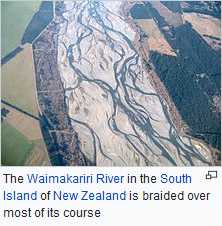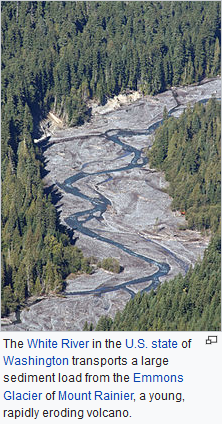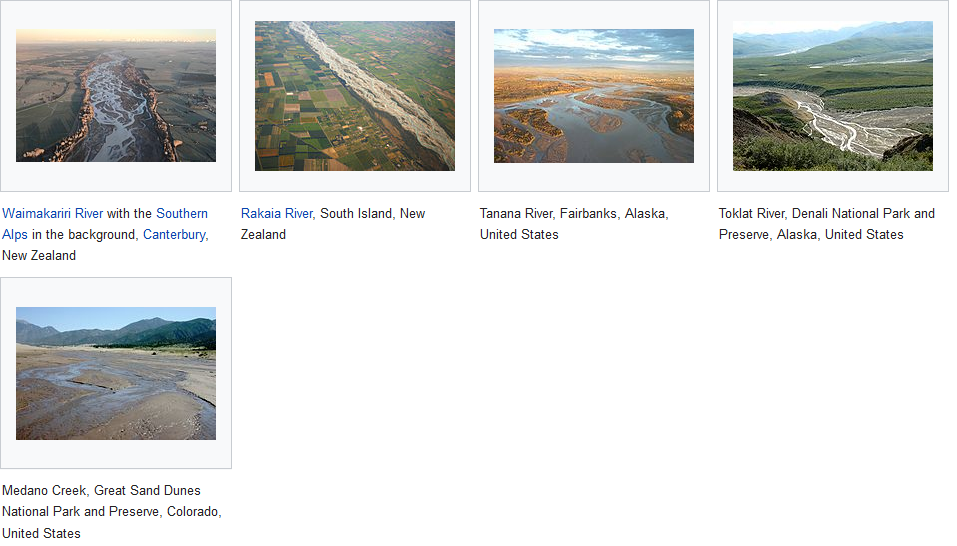What is a Braided Channel?
Braided rivers are significant subjects of study for some researchers, and the following sections describe and give light to the unique characteristics of these rivers. Braided channels, in essence, are made up of a network of smaller channels separated by small islands called braid bars. These fluvial channels are characterised by a single channel, with high gradation (slope), low sinuosity, and areas of highly irregular water regimes. These rivers are abundant in sediment, which has poor sorting, usually alternating between gravel and sand. The thalweg region in these channels is also known as the deepest portion where the most erosion occurs. At the max discharge of water, these fluvial rivers experience flooded channels, while at the minimum discharge of water, multiple bars and thalwegs become exposed. Usually, maximum discharge occurs during heavy rains and inclement weather. Examples of braided channels are those found near eroding mountains such as in Alaska, Canada, New Zealand’s South Island, and the Himalayas.
Braided channels are of interest to specialists from numerous fields of study. For the geomorphologist, braided channels are found inside upland and icy settings, and are responsible for erosion and transport events. For engineers, the high pace of silt transport, deposition, and erosion, together with channel moving and fast bank erosion may present considerable issues inside channel structures, e.g. connect wharves, streets, and railroads. Finally, for the geologist, braided rivers are significant agents of deposition that have been responsible for the formation of numerous sedimentary structures. Given these applications, knowledge of the mechanics and dynamics of braided rivers is crucial.

Zones of stream Convergence and Divergence
Braided rivers are described as having “a number of alluvial channels with bars or islands between meeting and dividing again, and presenting from the air the intertwining effect of a braid” (Lane 1957).

The division and joining of channels are key characteristics of braided rivers, and the bars inside these rivers have drawn the interest of both geomorphologists and sedimentologists. The stream elements and morphology of channel junctures have been concentrated on by many researchers (for example, Mosley 1976, 1982a; Best 1986, 1987, 1988; Best and Roy 1991; Roy and Roy 1988; Roy and Bergeron 1990; Roy et al. 1988); and ongoing consideration has featured the inexhaustible conjunctions of braided rivers (Ashmore 1982; Ashmore and Parker 1983; Klaassen and Vermeer 1988). In any case, the connection between stream convergence and the downstream division of streams has been disregarded. As a rule, stream dissimilarity is related to stream deceleration and residue deposition. When deposition has started, the sediment accumulation further advances stream division, deposition, and bar formation. Unique streams may likewise encroach on the bank at an expanded point, prompting bank erosion and channel augmenting. It is conceivable that some sedimentation may happen by vertical or even upstream accretion.

Bed shear pressure has appeared to increase in shallow streams over bar tops (Cheetham 1979), where a coarse defensive layer may form. In coarse-grained braided rivers, the bar heads might be characterised by the coarse-grained residue that is imbricated or overlaid (Bluck 1979).
The impact of stream stage

The appearance of braided rivers can change profoundly with flow organisation (see fig. 2 in Thorne et al.). A few researchers (including Doeglas 1962; Miall 1977) have suggested that variations in discharge are essential for the twisting of the rivers even though this may frequently be limited. Bluck (1979) theorized that bars may vanish at high stream stages, more so as discharge falls, and other theories have been accounted for by Smith (1974), Carson (1984), and Gupta and Dutt (1989). This may suggest that some braided rivers go about as single channels and embrace a trademark braided characteristic at the falling stage. These perceptions seem, by all accounts, to be genuinely surprising, and most braided rivers hold their bars at both high and low stream settings (Krigstrom 1962; Coleman 1969; Smith 1970; Cant and Walker 1978; Collin-child 1970; Church and Jones 1982; Bridge et al. 1986; Bristow 1987a).
Where bars exist for long periods of time, they will encounter numerous erosional and depositional events that alter their physical characteristics. At higher stream stages, when the most significant volumes of silt are moved, the channels are frequently scoured, bars might be diminished in stature and may be eroded. During the falling stage, most deposition happens as discharge and stream competence is diminished. As channel beds aggregate, the high stage bedforms might be changed, and new bars might be shaped or amplified as dregs are stored. As discharge keeps on falling, bars may rise and become dismembered by low stage channels.
The arrangement of emergent regions dependent on their low stage appearance might be misleading, and care should be taken in figuring out in which territories the bars are. Little information exists for the correlation of bar and channel morphology at various stream stages (however, observe Mosley 1982b), and this is a zone where controlled and accurately scaled flume models joined with field studies may contribute significantly to our understanding of these rivers.

If you’re interested to learn about and compare Braided Channels with Stream Channel Characteristics, keep reading!
Frequently Asked Questions
What are braided channels in rivers?
Braided channels are a type of river channel characterized by multiple interconnected and constantly shifting smaller channels separated by mid-channel bars or islands. These channels often occur in high-energy environments with abundant sediment supply.
What causes the formation of braided channels?
Braided channels form when a river carries a significant amount of sediment, and the flow energy is not sufficient to keep the sediment in a single, well-defined channel. The sediment load exceeds the river’s capacity, leading to the formation of multiple channels.
What are the typical features of braided channels?
Typical features of braided channels include mid-channel bars or islands made up of sediment deposits, shallow and variable water depths, rapid channel shifting, and an intricate network of interconnected channels.
What are the implications of braided channels for river management?
Braided channels can pose challenges for river management, as they often exhibit complex and dynamic patterns of flow and sediment transport. They can affect navigation, bridge stability, and flood risk, requiring careful planning and engineering interventions.
Are braided channels permanent or temporary features?
Braided channels can be both temporary and semi-permanent features. They can persist for varying durations, depending on factors such as sediment supply, river flow, and geomorphic processes. Some braided systems may evolve into meandering channels over time.
References
- Braided river. (n.d.). Retrieved from Wikipedia: https://en.wikipedia.org/wiki/Braided_river
- Braided rivers. (n.d.). Retrieved from One Geology: http://www.onegeology.org/extra/kids/earthProcesses/braidedRivers.html
- Braided rivers: perspectives and problems. (n.d.). Retrieved from https://sp.lyellcollection.org/: https://sp.lyellcollection.org/content/specpubgsl/75/1/1.full.pdf
- Braided rivers: perspectives and problems. (n.d.). Retrieved from Lyell Collections: https://sp.lyellcollection.org/content/75/1/1
